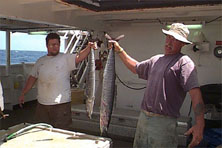Pacific Wahoo (Acanthocybium solanderi)
- Pacific wahoo population levels are estimated to be high, but no information is available as to whether overfishing is occurring or not.
- Wahoo is important to both commercial and recreational fisheries in Hawaii, and this species is commonly available in seafood markets.
- Wahoo is an excellent source of low-fat protein. For more information on nutrition, see Nutrition Facts. (USDA)
- Over 75% of the wahoo landed in the U.S. in 2006 came from Pacific fisheries; the rest originated in the Atlantic and Gulf region.
|
 |
 |
 |
 |
| Nutrition Facts |
| Servings 1 |
| Serving Weight
100g |
 |
| Amount Per Serving |
 |
| Calories 167 |
 |
| Total Fat |
9.36 g |
 |
| Total Saturated Fatty Acids |
2.444 g |
 |
| Carbohydrate |
0 g |
| Sugars |
0 g |
| Total Dietary
Fiber |
0 g |
 |
| Cholesterol |
64 mg |
 |
| Selenium |
39 mcg |
 |
| Sodium |
78 mg |
 |
| Protein |
19.32 g |
 |
|
 |
 Measuring the length of a wahoo. Wahoo can grow up to 5 feet long. Measuring the length of a wahoo. Wahoo can grow up to 5 feet long.
|
 |
Did you know?
Wahoo is frequently found alone or in small, loosely connected groups rather than compact schools.
Wahoo often associate with banks, pinnacles, and flotsam (natural debris drifting in the ocean).
Scientists have theorized that the wahoo is able to eat fish larger than itself by using its sharp teeth to render large prey into bite-size pieces.
|
|
| |
 |
|
Fishing for wahoo. In the Pacific, wahoo is mainly caught by longlining and trolling.
|
 |
|
The wahoo's snout is about as long as the rest of its head.
|
|
Sustainability Status
Biomass: Unknown
Overfishing: Unknown
Overfished: Unknown
Fishing and habitat: Wahoo are caught incidentally in longline and trolling fisheries, which have little impact on habitat.
Bycatch: Wahoo are caught incidentally in longline and trolling fisheries. In general, longlines interact with endangered and threatened species of sea turtles and marine mammals while targeting highly migratory species. Longline vessels also interact with a number of sea birds. Mitigation measures implemented on the U.S. longline fishery in the Pacific have significantly reduced interactions between longline gear and sea turtles and sea birds.
Aquaculture: There is currently no commercial aquaculture production of wahoo in the United States.
|
Science and Management
In the Pacific, wahoo is managed by the Western Pacific Fishery Management Council through the Pelagic Fisheries of the Western Pacific Region Fishery Management Plan (FMP). The FMP set up a framework for future management of pelagic fisheries the Exclusive Economic Zone (EEZ) of the U.S. Pacific Islands.
|
Life History and Habitat
Life history, including information on the habitat, growth, feeding, and reproduction of a species, is important because it affects how a fishery is managed.
- Geographic range: Wahoo are found in tropical and subtropical waters of the Atlantic, Pacific, and Indian Oceans, including the Caribbean and Gulf of Mexico. In the Pacific, wahoo are found between 46° N-35° S latitude.
- Habitat: Wahoo inhabit the pelagic area of tropical and subtropical waters.
- Life span: Short, with an estimated maximum of 9 years.
- Food: Wahoo are voracious predators, feeding on mackerels, butterfishes, porcupine fishes, round herrings, scads, jacks, pompanos, and flying fishes. They generally compete for the same kind of food as highly migratory tuna.
- Growth rate: Rapid
- Maximum size: The maximum reported size for wahoo is 158 pounds (IGFA World Record). Wahoo commonly attain sizes between 40 and 65 inches in length, with maximum size reaching 98 inches.
- Reaches reproductive maturity: Males mature at 34 inches and females mature at 40 inches. Both sexes of wahoo are capable of reproducing during the first year of life.
- Reproduction: Individual females may spawn many times during the season at short intervals. All tuna-like species have high reproductive rates, producing millions of eggs per year to compensate for the large percentage of eggs that do not survive to adults.
- Spawning season: Year-round in tropical waters and during the summer months in higher latitudes, including Hawaii. Spawning in the United States takes place from June to August.
- Spawning grounds: Tropical waters and higher latitude waters where surface temperatures are greater than 68-75° F.
- Migrations: Wahoo tend to be year-round residents in tropical waters, but they expand their range to more northern latitudes during the summer months.
- Predators: Young wahoo are prey for predators that inhabit the upper surface layer of tropical and subtropical oceans.
- Commercial or recreational interest: Both
- Distinguishing characteristics: Wahoo are covered with small scales and are steel blue above and pale blue below. It has a series of 25 to 30 irregular blackish-blue vertical bars on the sides. The fish has a large mouth with strong, triangular, compressed and finely serrate teeth. Its snout is about as long as the rest of the head.
|
Role in the Ecosystem
Most oceanic pelagic fish are opportunistic carnivores with variable diets. The major prey items can vary substantially during different stages of life, in different regions of the Pacific, and in different seasons.
|
Additional Information
Market name: Wahoo
Vernacular names: Kinkfish, Peto, Guarapucu, Ono, Thazard Batard
|
Biomass
Biomass refers to the amount of wahoo in the ocean. Scientists cannot collect and weigh every single fish to determine biomass, so they use models to estimate it instead. These biomass estimates can help determine if a stock is being fished too heavily or if it may be able to tolerate more fishing pressure. Managers can then make appropriate changes in the regulations of the fishery. To date there has been no attempt at a comprehensive stock assessment for wahoo. Therefore, the status of the stocks is unknown at this time.
Landings
 Landings refer to the amount of catch that is brought to land. In Hawaii, annual landings amount to about 400 metric tons (880,000 pounds). Market size is 5-20 kilograms (11-44 pounds). Landings refer to the amount of catch that is brought to land. In Hawaii, annual landings amount to about 400 metric tons (880,000 pounds). Market size is 5-20 kilograms (11-44 pounds).
Biomass and Landings
Are landings and biomass related? Landings are dependent on biomass, management measures in the fishery, and fishing effort.
Data sources:
Landings from NMFS Annual Commercial Landings Statistics using "WAHOO" as Species and "PACIFIC" as State
|
Important Dates
1987 – Western Pacific Pelagics Fishery Management Plan implemented
|
Notes and Links
General Information:
Managing Marine Fisheries of Hawaii and the U.S. Pacific Islands - Past, Present, and Future - Pelagic Fisheries
Fishery Management:
Pelagic Fisheries of the Western Pacific Region Fishery Management Plan
|
| |
|



